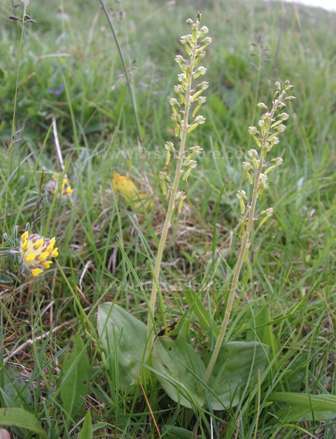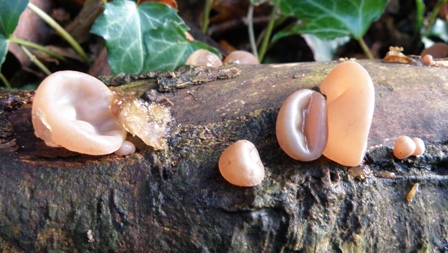Nant Porth Nature Reserve - North Wales Wildlife Trust Reserve, Near Bangor, North Wales
Below: Kidney Vetch and Common Twayblade grow at Nant Porth Nature Reserve

Nant Porth Nature Reserve drops down to a shingle beach on the Wales mainland side of the Menai Strait, and the shore of this reserve will form part of the proposed Marine Nature Reserve which will extend from Malltraeth on the west coast of Anglesey to Red Wharf Bay on the eastern side of the island.
The 20 acre site is leased by North Wales Wildlife Trust from the University College of North Wales and Arfon Borough Council.
The reserve is managed by North Wales Wildlife Trust (NWWT).
Directions
Grid Ref: SH556721
From Bangor follow the A5 road in the direction of Caernarfon. Nant Porth Nature Reserve lies off the road between Bangor and the Menai Suspension Bridge which leads directly to the town of Menai Bridge on Anglesey.
Access
The reserve is open all year round.
In the case of difficulty with access to Nant Porth Nature Reserve please contact North Wales Wildlife Trust. In May 2012 the All Wales Coast Path will be open and part of it will run through Nant Porth Nature Reserve and so new access arrangements will be in existence. In the meantime, access is possible from the shoreline (subject to tides so please check) via several public rights of way down to the beach.
The paths through this reserve are narrow and steep in places with steps. They can be slippery in wet weather and so good walking shoes are essential.
Facilities
There are no facilities at the reserve but you can find shops, cafes and public toilets in Bangor or in Menai Bridge on Anglesey both of which are only a few minutes away by car.
Description of Site
Below: Jelly Ear Fungus on a fallen branch

This reserve has such a variety of habitats and species of birds, flowers, trees and insects that it is of interest to almost anybody who loves the natural world.
Invertebrates such as Ragworm (Neris diversicolor), Lugworm (Areonicola marina) and Cockle (Cerastoderma edule) are particularly numerous in the mud exposed at low tide in Nant Porth and are a valuable source of food for waders and other birds. Curlew (Numenius arquata), Redshank (Tringa tetanus) and Oystercatcher (Heamatopus ostralegus) can all be seen there. Carrion Crows, Jackdaws and Rooks also visit the foreshore, and because of the diversity of habitats found in other parts of the reserve which include woodland and grassland, many other birds species are also found there, including Tree Creepers, Goldcrests and Nuthatches.
The main bedrock beneath the reserve is Carboniferous Limestone, and the kind of coastal ash woodland found at Nant Porth that grows on limestone is rare in the UK today. Where the tree canopy creates shade there are plants that are typical of limestone woodland such as Wood Sanicle (Sanicula europea), Lesser Celandine (Ficaria verna) and Dog’s Mercury (Mercuralis perennis). Another interesting tree found on the reserve is the Whitebeam - Sorbus porrigentiformis. The more open areas of limestone grassland are home to Common Spotted-orchid (Dactylorhiza fuchsii), Early Purple-orchid (Orchis mascula), Fragrant Orchid (Gymnadenia conopsea) and Common Twayblade (Neottia ovata). Other typical flowers of this type of grassland found on the reserve are Kidney Vetch (Anthyllis vulneraria), Common Rockrose (Heliathemum nummularium), Salad Burnet (Poterium sanguisorba) and many others.
Woodland nature reserves are excellent places to see fungi in autumn and Nant Porth is no exception. Pictured above is Jelly Ear Fungus (Auricularia auricula-judae) on a fallen branch. It is most frequently found on Elder trees but also on Beech and occasionally other trees, too.